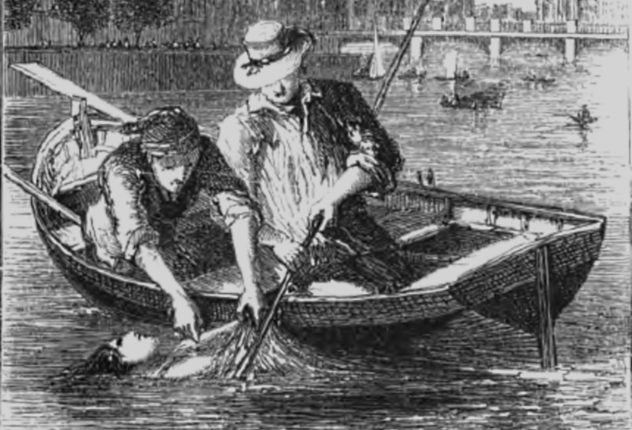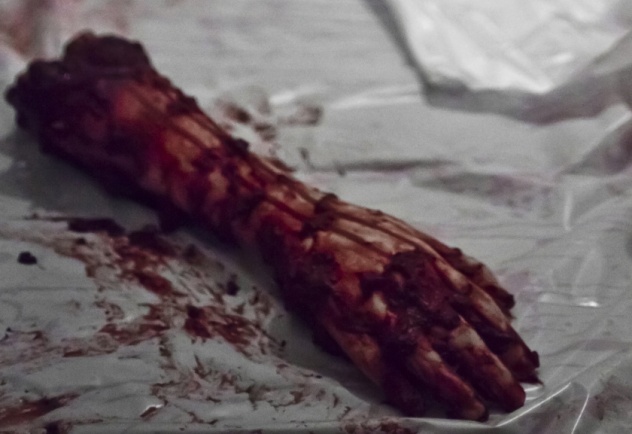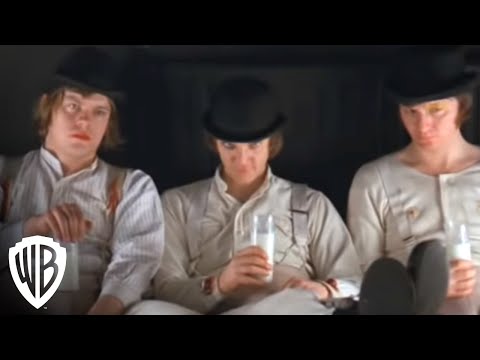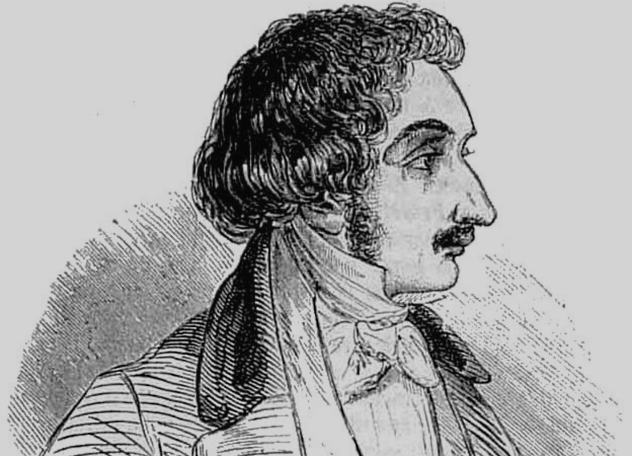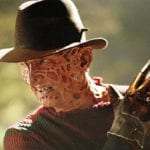Here’s the problem with that line of thinking: Some of the greatest examples of world literature deal with crime and the people who commit such antisocial acts. While this list is not meant to imply that each novel listed is “great,” it is meant to highlight the important role that real-life crime has played in the history of fiction.
10 The Great Gatsby
Considered an example of the much-vaunted “great American novel,” F. Scott Fitzgerald’s slim volume details the life of Jay Gatsby, a former North Dakota farm boy named James “Jimmy” Gatz who manages to turn himself from a dirt-poor Midwesterner into the talk of Long Island’s smart set. A seemingly carefree playboy with an endless amount of wealth, Gatsby is actually a lovestruck faker who made most of his money as a bootlegger. In particular, Gatsby’s black market money was made in conjunction with gangster Meyer Wolfsheim, whom Gatsby tells narrator Nick Carraway is “the man who fixed the World’s Series back in 1919.” If that’s true, then Meyer Wolfsheim can only be one man—Arnold Rothstein. A wealthy gambler who turned his profits into a string of casinos, brothels, and prized racehorses, Rothstein was ultimately shot and killed while playing cards at the upscale Park Central Hotel in Manhattan. Rothstein was a household name in the 1920s because, like the fictional Wolfsheim, he played a role in fixing the 1919 World Series between the Chicago White Sox and the Cincinnati Reds. In what became known as the Black Sox Scandal, Rothstein and other prominent gamblers bought off several White Sox players so that they would intentionally lose certain games, and eventually the World Series, so that Rothstein and company could reap the financial benefits. When several investigative journalists cottoned onto the poorly executed plan, eight White Sox players, including the illiterate “Shoeless” Joe Jackson, whom many see as the scandal’s greatest victim, were permanently banned from the sport. The Black Sox Scandal not only soured many on baseball, but it brought to light the tough reality that dirty money can control and manipulate on a large scale. As the preeminent cautionary tale about the American Dream ideal, The Great Gatsby was undoubtedly inspired by Rothstein, the 1919 World Series, and the rise of organized crime during the get-rich-quick era of the 1920s.
9 An American Tragedy
Written by Theodore Dreiser, the chief American proponent of naturalism, An American Tragedy tells a tale similar to The Great Gatsby (which was also released in 1925). Dreiser’s main character, Clyde Griffiths, is the lonely son of strict evangelists who falls for the temptations of the big city. After first finding a job as a soda jerk, Griffiths runs into misfortune and develops an unfortunate taste for alcohol and prostitutes. His real downfall, however, comes when he falls in love with Roberta Alden, another wayward youth trapped inside of what Dreiser considered to be America’s devouring labor marketplace. After impregnating Roberta, Clyde finds that a wealthy young woman named Sondra Finchley is interested in him, so he tries to talk Roberta into having an abortion. When Roberta refuses and insists upon marriage, Clyde devises a plan to murder Roberta. During a boat outing in upstate New York, Clyde accidentally kills Roberta, but due to the overwhelming evidence against him, Clyde is arrested, convicted, and executed for murder. Before sitting down to write his ambitious novel, Dreiser came across the case of Chester Gillette, the nephew of a wealthy factory owner who was convicted of murdering his girlfriend and their four-month-old baby in 1906. The son of poor soldiers for the Salvation Army, Gillette, age 22, found a job at a petticoat factory in Cortland, New York, thanks to his uncle Noah. While working in the factory, Gillette met 18-year-old Grace Brown, a poor farm girl from the tiny town of Otselic. Because his financial benefactor disapproved of him dating a “shop girl,” Gillette was under pressure to break off his relationship with Brown. When Brown revealed to Gillette that she was pregnant with their child, and thus should become his wife, Gillette asked her to have an abortion in order to avert a scandal. Grace refused, so Gillette hatched a plan to get rid of both problems once and for all. On November 12, 1906, Gillette supposedly pushed Brown off their rented boat on Big Moose Lake. In spite of a lack of eyewitness testimony, the prosecution managed to convict Gillette of the murder, and he went to the electric chair two years later.
8 The High Window
Considered one of Raymond Chandler’s more forgettable Phillip Marlowe novels, The High Window (1942) is nevertheless a classic noir tale about the abuses of money and power. When Marlowe is hired by the wealthy yet reckless matron Elizabeth Bright Murdock to find a Brasher Doubloon, a rare and highly valuable coin from the 18th century, he stumbles upon an intra-family drama involving the rebellious Leslie Murdock, his club singer wife Linda Conquest, and former family patriarch Horace Bright. Bright is of particular interest because his 1929 suicide is called into question by Marlowe. While talking to Detective Lieutenant Breeze, Marlowe works out the problems inherent in the Murdock family by discussing the “Cassidy Case.” After giving Lieutenant Breeze the details of the crime, Marlowe then goes on to assert that the investigation was officially stymied from the beginning due to the influence of Cassidy’s rich father. Unbeknownst to many, the Cassidy Case is an actual retelling of the Ned Doheny case from 1929. On February 17, 1929, Ned Doheny, the son of Edward L. Doheny (one of California’s wealthiest oilmen), was found dead not far from the corpse of his secretary, Hugh Plunkett, inside the Doheny’s Greystone Mansion in Beverly Hills. The initial theory composed at the crime scene was that Plunkett had killed Doheny in a drunken rage, but many investigators (including future crime writer Leslie White, who worked at the DA’s office), were suspicious of this conclusion. When District Attorney Burton Fitts’s proclamations of a “sweeping investigation” fizzled out almost immediately, many started to suspect that the elder Doheny, a man with connections to the IRA, the Teapot Dome scandal, and some black money in Mexico, had gotten the DA’s ear. Rumors still abound that Doheny and Plunkett were gay lovers, and some see the case as being related to the festering Teapot Dome scandal.
7 ‘The Tell-Tale Heart’
One of the greatest horror tales in the English language, Edgar Allan Poe’s “The Tell-Tale Heart” is a strange account of an unnamed narrator’s hateful obsession with an old blind man’s clouded, blue eye. Believing the eye to be an “evil eye,” the narrator springs upon the old man while he is sleeping one night. After killing and dismembering his victim, the narrator hides the remaining body parts underneath the floorboards inside of the old man’s home. In spite of his confidence, the narrator begins to lose his remaining sanity when he starts to hear the old man’s heart beating underneath the floorboards. Driven mad by the ghostly heart palpitations, the narrator finally confesses to the police and shows them what’s left of the old man. The brilliance of “The Tell-Tale Heart” is that its paranoid narrator is one of the earliest and most in-depth depictions of criminal psychology in popular fiction. Some of this may have been due to the fact that Poe was partially inspired by a real murder. In 1830, the witch-haunted town of Salem, Massachusetts, was rocked by a shocking and brutal murder. On the night of April 6, 1830, during a full moon, Captain Joseph White, who lived in one of Salem’s most opulent homes, was bludgeoned to death by an unknown assailant. Although none of Captain White’s grand wealth was disturbed at the scene, the culprits behind the murder, White’s great-nephew Joseph Knapp and his brother John, were inspired to hire a hit man in order to receive the old man’s sizable inheritance. The case became a huge story due to the sensational nature of the crime, as well as the famous setting (Salem). Chief prosecutor Daniel Webster also helped to turn just another murder into something socially important. Webster’s brilliantly slow summation of the murder before the jury helped Poe to create his unnamed murderer.
6 ‘The Mystery Of Marie Roget’
In addition to his famous short horror stories, Poe also wrote some of the earliest examples of modern crime fiction. In particular, his detective, C. Auguste Dupin, not only participated in what is considered to be the first true detective tale (“The Murders in the Rue Morgue”), but he directly influenced the much more famous Sherlock Holmes. In the 1842 short story “The Mystery of Marie Roget,” Dupin and his unnamed sidekick (who himself was a model for Dr. Watson) ruminate about the unsolved murder of Roget, a perfume shop worker whose body was found by police in the Seine. Unlike Dupin’s other two detective stories, the famous Parisian detective doesn’t do much in the way of physical activity in “The Mystery of Marie Roget.” Years before Nero Wolfe, the obese New York detective who manages to solve crimes without having to leave his comfortable brownstone apartment, Dupin uses the power of “ratiocination” from the depths of his own study in order to solve the case. “The Mystery of Marie Roget” is a unique detective story in that it is less about fiction and more about a real-life murder. The story presents nothing more than Poe’s own thoughts about the murder of Mary Rogers, a beautiful teenager and cigar store worker whose body was found not far from Sybil’s Cave in Hoboken, New Jersey, on July 28, 1841. In spite of an earlier disappearance in 1838 that included a supposed suicide letter, Roger’s body showed signs that she had been murdered and was not the victim of her own hand. The case, which remains unsolved, once featured suspects including members of New York’s notorious street gangs and an abortionist named Madame Restell.
5 The Girl With The Dragon Tattoo
The first installment of Stieg Larsson’s posthumously published Millennium series, The Girl With the Dragon Tattoo became an immediate hit upon its publication in 2005. Since then, the novel has sold millions of copies worldwide and has attracted the attention of continuation authors interested in keeping the characters alive. The Swedish novel, which was originally titled Men Who Hate Women, deals with a libel case against the investigative reporter Mikael Blomkvist. Blomkvist, who desperately wants to clear his name, accepts a proposition from Henrik Vanger, a corporate CEO. Vanger wants Blomkvist to learn what actually happened to his missing niece, Harriet Vanger, in return for helping to expose Hans-Erik Wennerstrom (the businessman who sued Blomkvist) as a criminal. As part of the investigation, Blomkvist befriends private investigator and former computer hacker Lisbeth Salander. Salander, a rape survivor, helps Blomkvist to uncover not only a connection between a decades-old serial killer and the Vanger family, but also the true extent of Wennerstrom’s corruption. The Girl With the Dragon Tattoo is known for its explicit rape scenes, which help to further the novel’s emphasis on the unholy confluence of wealth, power, and sociopathic male behavior. Larsson, who was an investigative journalist himself and the founder of the far-left magazine Expo, was partially inspired to write the novel after researching the case of Catrine da Costa, a 28-year-old prostitute and heroin addict who was found in pieces scattered throughout Stockholm in the summer of 1984. Da Costa, whose head, internal organs, genitals, and one of her breasts were never found, was originally believed to be the victim of two doctors, one of whom was a forensic pathologist known to frequent the city’s many prostitutes. Although the doctors were arrested for murder, the case remains open after a mistrial and two acquittals. While some point out that Lisbeth Salander was based on a real rape survivor named Lisbeth, the notoriety of the Catrine da Costa case undoubtedly influenced Larsson’s novel.
4 Red Harvest
When Dashiell Hammett’s Red Harvest was released in 1929, detective fiction still mostly belonged to British writers who wrote quaint murder mysteries involving isolated country manors, elaborate puzzles, and eccentric, brilliant private detectives. Hammett, a former Pinkerton operative, set out to make detective fiction more realistic and, in turn, more violent. Red Harvest, his first novel, is set in the western mining town of Personville, which is better known as Poisonville due to its high crime rate. The Continental Op, Hammet’s short, chubby, yet tough detective, was initially brought in by the crusading newspaper publisher Donald Willsson. The Op falls into not only Willsson’s murder investigation, but also a gang war involving the many crooks in Poisonville. In a brilliant bit of strategy, the Op solves one of his problems by engineering several gang-on-gang killings. This plotline, along with the entire novel itself, has been adapted several times on the screen, including Akira Kurosawa’s Yojimbo. Hammett brought more than his firsthand knowledge of the private detective business to mystery fiction; he also dumped some of his past experiences onto his fictional characters. Red Harvest was inspired by both a miners’ strike in Montana that lasted from 1912–20, as well as the lynching of IWW labor leader Frank Little. We’ve talked about this case before. In short, Hammett was a Pinkerton detective working in Butte, Montana, in 1917—during the protracted miners’ strike. Hammett’s job was to break up the strike. But when a man from Anaconda Copper offered him $5,000 to kill Little, the union organizer, Hammett backed away in disgust. Whether or not this story is true, Little was eventually lynched by six unknown men in August 1917.
3 The Night Of The Hunter
Before it became a critically acclaimed movie in 1955, The Night of the Hunter was a successful novel written by West Virginia author Davis Grubb in 1953. It concerns the murderous ex-convict Harry Powell, who, under the guise of “Reverend Powell,” cons his way into marrying Willa Harper, the wife of a former thief named Ben Harper. In order to get the loot from Harper’s last robbery, Powell kills Willa and then goes after her children, whom Powell believes know too much. A haunting novel set against the backdrop of the Great Depression, The Night of the Hunter manages to be both a crime novel and an excellent example of the Southern Gothic tradition. Harry Powell was based on Harry Powers (pictured above), a serial killer who operated in the hamlet of Quiet Dell, West Virginia, during the early 1930s. A swindler who was born in the Netherlands under the name of Herman Drenth, Powers came to the US at age 18. After marrying Luella Strother, having read her advertisement in a Lonely Hearts type of magazine, Powers hit on the idea of cheating widows out of their fortunes via fabricated ads. Before his capture in 1931, the “Bluebeard of Quiet Dell” managed to kill two women and three children that we know of. He may have killed many more.
2 A Clockwork Orange
A Clockwork Orange is without question the most infamous book on this list. Written by British writer Anthony Burgess in 1962, the novel presents a dystopian England overrun with violent teenagers. One teenager in particular, Alex, is the head of a gang of “droogs,” who spout cryptic Anglo-Russian slang while participating in random acts of “ultra-violence.” Inspired by the music of Ludwig van Beethoven, drug-infused milk, and his own sociopathic impulses, Alex leads the droogs on nightly missions of violence. One such incident (the beating and murder of a wealthy older woman) spurs Alex’s droogs into sending him to the police. While in prison, Alex is subjected to a mind control experiment known as the Ludovico Technique, which tries to eradicate his thirst for violence through brutal aversion therapy. Ultimately, the experiment fails, and Alex goes back to committing crimes with his droogs, although he is not as enthusiastic as he once was. Burgess’s novel highlights the idea that violence is inborn in the human character. Only maturity, Burgess argues, can rid people of their most antisocial thoughts. Burgess’s dim view of youth was largely formed by his interest in the Teddy Boys subculture of postwar England. After writing the first draft of his novel, Burgess also traveled to the Soviet Union and saw the gang problems there firsthand. On a more personal note, Burgess was deeply influenced by his first wife’s encounter with a gang of US soldiers, who beat and robbed her during the London blackout of 1944.
1 Crime And Punishment
Fyodor Dostoyevsky’s 1866 novel Crime and Punishment takes the experience of crime to an almost transcendent level. The novel is told from the perspective of Rodion Raskolnikov (whose surname comes from the Russian word for “schism”), an impoverished ex-student who decides to murder a moneylender in order to rob her of her ill-gotten money. In Crime and Punishment, Raskolnikov’s motivations and justifications for his crime matter more than the crime itself. For the majority of the novel, we, the readers, are trapped inside of Raskolnikov’s warped psyche. For him, the moneylender is a social parasite (or a “trembling vermin”) who contributes nothing to society. On the other hand, Raskolnikov believes that he is a superior individual who can and should be allowed to commit such an act. As evidence of Raskolnikov’s inflated ego, he compares himself to Napoleon several times in the novel. Amazingly, Dostoyevsky managed to accurately depict the ego-driven type of murderer years before the school of criminal profiling even began. Raskolnikov is a fictional precursor to Leopold and Loeb, two highly educated and wealthy Chicago boys who murdered 14-year-old Bobby Franks because they believed they were Nietzschaen “overmen” and therefore capable of committing the perfect crime, as well as William Edward Hickman, a child murderer who declared that, “I am like the state; what is good for me is right.” For his own part, Dostoyevsky was influenced by the criminal Pierre Lacenaire (pictured above), a murderer and swindler who documented his own crimes as part of a wider philosophy which dictated that, “To kill without remorse is the highest of pleasures.” Lacenaire, whom Dostoyevsky mentions by name in his 1869 novel The Idiot, became an antihero in France for espousing anarchistic, anti-bourgeois views, even during his trial for a double homicide in 1836. After Lacenaire’s execution, Dostoyevsky continued to see him as the archetype for those criminals who use (or abuse) modern philosophy in order to validate their most savage compulsions. Benjamin Welton is a freelance writer based in Boston. His work has appeared in The Atlantic, The Weekly Standard, Listverse, Metal Injection, and others. He currently blogs at literarytrebuchet.blogspot.com. Read More: Twitter Facebook The Trebuchet




